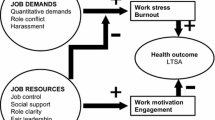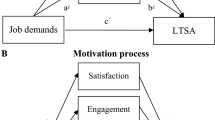Abstract
Purpose
(1) Determine the relationship between emotional dissonance and medically certified sickness absence among employees working with clients and (2) compare the impact of emotional dissonance on medically certified sickness absence with the impact of other psychological and social work factors.
Methods
A sample of 7758 employees was recruited from 96 Norwegian organizations in the period 2004 to 2014, all working with clients. The study design was prospective with emotional dissonance measured at baseline and then linked to official registry data of medically certified sickness absence for the year following the survey assessment. Quantitative demands, decision demands, role clarity, role conflict, control over work intensity, and decision control were included as additional work exposures. The impact of the study variables on the presence and duration of medically certified sickness absence was investigated with a negative binomial hurdle model.
Results
In the fully adjusted model, emotional dissonance and role conflict significantly predicted the presence of medically certified sickness absence. Control over work intensity and decision control were negatively related to presence of sickness absence. Only role conflict was a risk factor for the duration of sickness absence when all factors were analysed simultaneously.
Conclusion
Emotional dissonance is a risk factor for the presence of medically certified sickness absence in client-driven work environments. Theoretical models of sickness absence, as well as interventions aiming to prevent sickness absence in such environments, should be aware of the effect emotional dissonance may have on employees.
Similar content being viewed by others
References
Aagestad C, Johannessen HA, Tynes T, Gravseth HM, Sterud T (2014a) Work-related psychosocial risk factors for long-term sick leave: a prospective study of the general working population in Norway. J Occup Environ Med 56:787–793. doi:10.1097/JOM.0000000000000212
Aagestad C, Tyssen R, Johannessen HA, Gravseth HM, Tynes T, Sterud T (2014b) Psychosocial and organizational risk factors for doctor-certified sick leave: a prospective study of female health and social workers in Norway. BMC Public Health 14:1016. doi:10.1186/1471-2458-14-1016
Allebeck P, Mastekaasa A (2004) Swedish Council on Technology Assessment in Health Care (SBU). Chapter 5. Risk factors for sick leave—general studies. Scand J Public Health Suppl 63:49–108. doi:10.1080/14034950410021853
Bakker AB, Heuven E (2006) Emotional dissonance, burnout, and in-role performance among nurses and police officers. Int J Stress Manag 13:423–440. doi:10.1037/1072-5245.13.4.423
Baruch Y, Holtom BC (2008) Survey response rate levels and trends in organizational research. Hum Relat 61:1139–1160
Cameron AC, Trivedi PK (1998) Regression analysis of count data. Cambridge University Press, Cambridge
Christensen JO, Knardahl S (2010) Work and neck pain: a prospective study of psychological, social, and mechanical risk factors. Pain 151:162–173. doi:10.1016/j.pain.2010.07.001
Christensen KB, Andersen PK, Smith-Hansen L, Nielsen ML, Kristensen TS (2007) Analyzing sickness absence with statistical models for survival data. Scand J Work Environ Health 33:233–239
Clausen T, Nielsen K, Carneiro IG, Borg V (2012) Job demands, job resources and long-term sickness absence in the Danish eldercare services: a prospective analysis of register-based outcomes. J Adv Nurs 68:127–136. doi:10.1111/j.1365-2648.2011.05724.x
Cohen J (1988) Statistical power analysis for behavioral sciences. Lawrence Erlbaum, Hillsdale
Corp I (2015) IBM SPSS Statistics for Windows. Version 23.0. IBM Corp, Armonk
Cortina JM, Landis RS (2009) When small effect sizes tell a big story, and when large effect sizes don’t. In: Vandenberg CELRJ (ed) Statistical and methodological myths and urban legends: doctrine, verity and fable in the organizational and social sciences. Routledge, New York, pp 287–308
Côté S, Morgan LM (2002) A longitudinal analysis of the association between emotion regulation, job satisfaction, and intentions to quit. J Organ Behav 23:947–962. doi:10.1002/job.174
Dallner M et al (2000) Validation of the general Nordic questionnaire (QPSNordic) for psychological and social factors at work. Nordic Council of Ministers, Copenhagen
de Jonge J, Dollard M, Dormann C, Le Blanc P, Houtman ID (2000) The demand-control model: specific demands, specific control, and well-defined groups. Int J Stress Manag 7:269–287
Diestel S, Schmidt KH (2010) Interactive effects of emotional dissonance and self-control demands on burnout, anxiety, and absenteeism. J Vocat Behav 77:412–424. doi:10.1016/j.jvb.2010.05.006
Dolphin T (ed) (2015) Technology, globalisation and the future of work in Europe: essays on employment in a digitised economy. IPPR, London
Dormann C, Zapf D (2004) Customer-related social stressors and burnout. J Occup Health Psychol 9:61–82. doi:10.1037/1076-8998.9.1.61
Duijts SF, Kant I, Swaen GM, van den Brandt PA, Zeegers MP (2007) A meta-analysis of observational studies identifies predictors of sickness absence. J Clin Epidemiol 60:1105–1115. doi:10.1016/j.jclinepi.2007.04.008
Edwards JR (1991) Person-job fit: a conceptual integration, literature review, and methodological critique. In: Robertson CLCIT (ed) International review of industrial and organizational psychology, 1991, vol 6. International review of industrial and organizational psychology. Wiley, Oxford, pp 283–357
Emberland JS, Knardahl S (2015) Contribution of psychological, social, and mechanical work exposures to low work ability: a prospective study. J Occup Environ Med 57:300–314. doi:10.1097/JOM.0000000000000353
Eurofound (2012) Fifth European working conditions survey. Publications Office of the European Union, Luxembourg
Eurofound (2015) First findings: sixth European working conditions Survey-Résumé. http://www.eurofound.europa.eu/sites/default/files/ef_publication/field_ef_document/ef1568en.pdf. Accessed 7 Jun 2016
Finne LB, Christensen JO, Knardahl S (2014) Psychological and social work factors as predictors of mental distress: a prospective study. PLoS ONE 9:e102514. doi:10.1371/journal.pone.0102514
Grandey AA (2000) Emotion regulation in the workplace: a new way to conceptualize emotional labor. J Occup Health Psychol 5:95–110
Grandey AA (2003) When “the show must go on”: surface acting and deep acting as determinants of emotional exhaustion and peer-rated service delivery. Acad Manag J 46:86–96. doi:10.2307/30040678
Hernan MA, Hernandez-Diaz S, Robins JM (2004) A structural approach to selection bias. Epidemiology 15:615–625
Hochschild AR (1983) The managed heart. Commercialization of human feeling. University of California Press, Berkeley
Hsieh CW, Jin MH, Guy ME (2012) Consequences of work-related emotions: analysis of a cross-section of public service workers. Am Rev Public Adm 42:39–53. doi:10.1177/0275074010396078
Hulsheger UR, Schewe AF (2011) On the costs and benefits of emotional labor: a meta-analysis of three decades of research. J Occup Health Psychol 16:361–389. doi:10.1037/a0022876
Karasek RA (1979) Job demands, job decision latitude, and mental strain—implications for job redesign. Adm Sci Q 24:285–308. doi:10.2307/2392498
Kivimaki M et al (2001) Sickness absence in hospital physicians: 2 year follow up study on determinants. Occup Environ Med 58:361–366. doi:10.1136/oem.58.6.361
Knardahl S, Sterud T, Nielsen MB, Nordby K-C (2016) Arbeidsplassen og sykefravær - Arbeidsforhold av betydning for sykefravær Tidsskrift for velferdsforskning 1
Lewig KA, Dollard MF (2003) Emotional dissonance, emotional exhaustion and job satisfaction in call centre workers. Eur J Work Organ Psychol 12:366–392. doi:10.1080/13594320344000200
Lund T, Labriola M, Christensen KB, Bultmann U, Villadsen E, Burr H (2005) Psychosocial work environment exposures as risk factors for long-term sickness absence among Danish employees: results from DWECS/DREAM. J Occup Environ Med 47:1141–1147. doi:10.1097/01.jom.0000174301.80318.f2
Marmot M, Feeney A, Shipley M, North F, Syme SL (1995) Sickness absence as a measure of health-status and functioning—from the UK Whitehall-II study. J Epidemiol Commun Health 49:124–130. doi:10.1136/jech.49.2.124
Mazzocchi M (2008) CHAPTER 5 Sampling. Statistics for marketing and consumer research. Sage, London. doi:10.4135/9780857024657
Melchior M, Niedhammer I, Berkman L, Goldberg M (2003) Do psychosocial work factors and social relations exert independent effects on sickness absence? A six-year prospective study of the GAZEL cohort. J Epidemiol Community Health 57:285–293
Morris JA, Feldman DC (1996) The dimensions, antecedents, and consequences of emotional labor. Acad Manag Rev 21:986–1010. doi:10.2307/259161
Mullahy J (1986) Specification and testing of some modified count data models. J Econom 33:341–365. doi:10.1016/0304-4076(86)90002-3
Nguyen H, Groth M, Johnson A (2013) When the going gets tough, the tough keep working: impact of emotional labor on absenteeism. J Manag 42:615–643. doi:10.1177/0149206313490026
Niedhammer I, Chastang JF, Sultan-Taieb H, Vermeylen G, Parent-Thirion A (2013) Psychosocial work factors and sickness absence in 31 countries in Europe. Eur J Public Health 23:622–629. doi:10.1093/eurpub/cks124
Nielsen MB, Christiansen S, Indregard AM, Emberland JS, Elka S, Knardahl S (2016) The new workplace II: protocol for a prospective full-panel registry study of work factors, sickness absence, and exit from working life among Norwegian employees. Springerplus 5:243. doi:10.1186/s40064-016-1896-z
North F, Syme SL, Feeney A, Head J, Shipley MJ, Marmot MG (1993) Explaining socioeconomic differences in sickness absence: the Whitehall II study. BMJ 306:361–366
North F, Syme S, Feeney A, Shipley M, Marmot M (1996) Psychosocial work environment and sickness absence among British civil servants: the Whitehall II study. Am J Public Health 86:332–340
Pandey J, Singh M (2016) Donning the mask: effects of emotional labour strategies on burnout and job satisfaction in community healthcare. Health Policy Plan 31:551–562. doi:10.1093/heapol/czv102
Podsakoff PM, MacKenzie SB, Lee JY, Podsakoff NP (2003) Common method biases in behavioral research: a critical review of the literature and recommended remedies. J Appl Psychol 88:879–903. doi:10.1037/0021-9010.88.5.879
Roelen CA, Koopmans PC, Bultmann U, Groothoff JW, van der Klink JJ (2009) Psychosocial work conditions and registered sickness absence: a 3-year prospective cohort study among office employees. Int Arch Occup Environ Health 82:1107–1113. doi:10.1007/s00420-009-0425-6
Rugulies R, Christensen KB, Borritz M, Villadsen E, Bultmann U, Kristensen TS (2007) The contribution of the psychosocial work environment to sickness absence in human service workers: results of a 3-year follow-up study. Work Stress 21:293–311. doi:10.1080/02678370701747549
Rugulies R, Aust B, Pejtersen JH (2010) Do psychosocial work environment factors measured with scales from the Copenhagen Psychosocial Questionnaire predict register-based sickness absence of 3 weeks or more in Denmark? Scand J Public Health 38:42–50. doi:10.1177/1403494809346873
Slany C, Schutte S, Chastang JF, Parent-Thirion A, Vermeylen G, Niedhammer I (2014) Psychosocial work factors and long sickness absence in Europe. Int J Occup Environ Health 20:16–25. doi:10.1179/2049396713Y.0000000048
Soderfeldt B, Soderfeldt M, Muntaner C, O’Campo P, Warg LE, Ohlson CG (1996) Psychosocial work environment in human service organizations: a conceptual analysis and development of the demand-control model. Soc Sci Med 42:1217–1226
StataCorp (2015) Stata statistical software: release 14. StataCorp LP, College Station
Vegchel N, Jonge J, Söderfeldt M, Dormann C, Schaufeli W (2004) Quantitative versus emotional demands among Swedish human service employees: moderating effects of job control and social support. Int J Stress Manag 11:21–40
Wannstrom I, Peterson U, Asberg M, Nygren A, Gustavsson JP (2009) Psychometric properties of scales in the General Nordic Questionnaire for Psychological and Social Factors at Work (QPS): confirmatory factor analysis and prediction of certified long-term sickness absence. Scand J Psychol 50:231–244. doi:10.1111/j.1467-9450.2008.00697.x
Wharton AS (1993) The affective consequences of service work—managing emotions on the job. Work Occup 20:205–232. doi:10.1177/0730888493020002004
Whitaker SC (2001) The management of sickness absence. Occup Environ Med 58:420–424
Zapf D (2002) Emotion work and psychological well-being. Hum Resour Manag Rev 12:237–268. doi:10.1016/s1053-4822(02)00048-7
Zapf D, Holz M (2006) On the positive and negative effects of emotion work in organizations. Eur J Work Organ Psychol 15:1–28. doi:10.1080/13594320500412199
Zapf D, Dormann C, Frese M (1996) Longitudinal studies in organizational stress research: a review of the literature with reference to methodological issues. J Occup Health Psychol 1:145–169
Zapf D, Vogt C, Seifert C, Mertini H, Isic A (1999) Emotion work as a source of stress: the concept and development of an instrument. Eur J Work Organ Psychol 8:371–400. doi:10.1080/135943299398230
Zapf D, Seifert C, Schmutte B, Mertini H, Holz M (2001) Emotion work and job stressors and their effects on burnout. Psychol Health 16:527–545. doi:10.1080/08870440108405525
Acknowledgements
This study was funded by the Norwegian Research Council. The authors would like to thank the participating companies for their willingness to participate, and Anne Lene Andersen Watn, Bjørn Lau, Jan Emberland, Margrethe Schøning, Shahrooz Elka, and Jan Olav Christensen for their assistance in the survey administration.
Author information
Authors and Affiliations
Corresponding author
Ethics declarations
Conflict of interest
The authors declare that they have no conflict of interest.
Rights and permissions
About this article
Cite this article
Indregard, AM.R., Knardahl, S. & Nielsen, M.B. Emotional dissonance and sickness absence: a prospective study of employees working with clients. Int Arch Occup Environ Health 90, 83–92 (2017). https://doi.org/10.1007/s00420-016-1176-9
Received:
Accepted:
Published:
Issue Date:
DOI: https://doi.org/10.1007/s00420-016-1176-9




